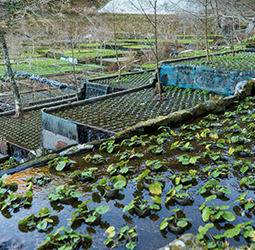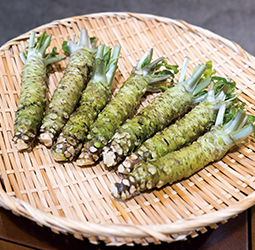Home > Highlighting JAPAN >Highlighting Japan March 2016>Delectable Journeys
Highlighting JAPAN


- PREVIOUS
- NEXT
Japan’s Fiery, Flavorful Root—Wasabi
Wasabi is Japan’s signature condiment. There is no substitute for the pleasurable burn on your palate of the grated goodness of this herb.
If you’ve eaten sushi or sashimi, you’ve no doubt tasted wasabi. The wasabi that grows along the mountain streams in each region of Japan has long been known as a medicinal agent, said to have been used for its antibacterial and deodorizing effects since as early as the Asuka Period (592-710). Tokugawa Ieyasu, famed epicure and first shogun of the Edo Period (1603-1868), loved this seasoning, and is said to have carefully proscribed its cultivation. The region he entrusted its production to was Shizuoka Prefecture.
Eighty percent of the wasabi shipped to Japanese markets is now cultivated in Shizuoka Prefecture—and the Izu Peninsula stands as Shizuoka’s greatest wasabi-producing region. With its characteristic warm climate, the peninsula is known as a home of hot springs and resorts where visitors can enjoy a variety of marine sports.
The land here is mountainous, explains wasabi farmer Hirotsugu Shioya, who tends a steep, terraced plot overlooking Izu City. The scent is of earth meeting rushing water in the cold mountain air, and green sprouts of various sizes spread out across watery paddies up and down the hillside. The greenery is divided by spindly trails that look almost wide enough for a goat, but prove wide enough to support nimble farmers examining their plants.
“Wasabi is really dependent on water, the air and the environment,” says Shioya. The water here is incredibly clean and fresh, and wasabi grown in Shizuoka use all the blessings of nature, such as the runoff from Mount Fuji. Another challenge to raising the finicky crop is the time required: anywhere from a year and a half to two years for the plant to grow big enough to harvest.
Back at the foot of the mountain at the Izu Agriculture Research Center, fourth- and fifth-generation wasabi farmers congregate to talk shop. When pressed, they share some of their favorite ways to eat the plant. Several mention wasabi-don, which is made by mixing wasabi with soy sauce and shaved bonito on top of rice. Others like it with grilled meat, while one reminisces about how his grandfather put it in the breakfast miso soup. Another says he relishes “negi-toro (scallions and fatty tuna) with plenty of wasabi—and a good cry.”
Just a short distance from the center is a small local restaurant called Izu no Sataro, where another farmer’s recommendation is being served for lunch: local homemade soba noodles with fresh wasabi grated directly on top. The bright green herb clings in flecks to the toothy noodles, which act as the ideal canvas for the fresh, sharp balance of sweet and spicy that shoots straight up the nose before a quick breath dissipates the sensation.
Further along the road toward Mount Fuji is the Mishima Wasabi Factory, a bazaar dedicated to wasabi that’s popular with daytrippers. The Mishima Wasabi Factory is also the company store of Yamamoto Foods, a purveyor of Shizuoka wasabi products. Fourth-generation president Yutaka Yamamoto wants visitors to experience Izu and, more specifically, wasabi. “Wasabi can be used in various interesting and delicious dishes,” says Isao Yamamoto, Yutaka’s brother. “You can enjoy it not only with sashimi, but also with meat, cheese and other foods.” Their most popular products include wasabi mayonnaise, wasabi shrimp crackers, and an oil-based seasoning made from wasabi powder in olive oil.
Although the whole plant is spicy, the part most often used to produce the familiar green paste is the rhizome, which serves as the plant’s stem. And there’s a specific way to grind it, Yutaka explains. First you should strip the leaves off the top rather than lopping them off, which preserves the precious, tasty, sharp-scented part. Then use a quality grinder such as shark skin, preferably one made specifically for wasabi; a fine grinding surface will produce a silkier paste, while a coarser one will produce a grittier result. Finally, he says, you must “grind slowly, in a circular motion, with a smile.” It may sound funny, but he says that’s essential, because grinding while calm and happy will mean a lighter and gentler touch, while grinding in haste or anger will yield sloppy, haphazard results.
Next up is Shizuoka’s neighboring wasabi-producing prefecture, Nagano. Boasting nature on a grand scale, Nagano can be accessed from Tokyo within an hour and a half by bullet train, drawing crowds of people seeking to fill their days off with skiing, hot springs or hiking.
Daio Wasabi Farm is situated in the Azumino region of Nagano Prefecture. Spanning 15 hectares, the farm yields about 130 tons of wasabi per year, which is about 10 percent of total domestic production. Fed by snowmelt from Japan’s Northern Alps, the fields here are flat rather than terraced, and the
wasabi is planted in pebbly soil furrows with water running through them.
The picturesque farm is open to visitors year-round, and some guests may recognize that parts of the farm appeared in the Akira Kurosawa film Dreams. In addition to the gently undulating green fields of wasabi and light glinting off the clear water, there are water wheels, thatched roof huts, wooden bridges and even a small Shinto shrine. There’s also wasabi master farmer Shigetoshi Hama, who inspects the plants every morning. Carrying a blade, a grinder and a thermometer tucked into his belt above his gumboots, Hama makes sure the water temperature is suitable (i.e., a fairly constant 13ºC) and sees that the plants get the right mix of sun and shade.
In addition to strolling the farm, visitors can try their hand at making wasabizuke, a condiment made by blending chopped wasabi leaves and upper stems with sake kasu—the lees left over from making sake. Wasabizuke goes nicely on rice, either plain or donburi style. There are also a few places to try wasabi-based foodstuffs on the farm: a food cart food court serving wasabi croquettes and soft serve ice cream, as well as a cafeteria offering wasabi curry, wasabi beer, and the house specialty, wasabi-don. This latter dish uses the excellent local rice as a base and is topped with shaved bonito, white sesame, scallions and kizami-nori flakes, along with a side of wasabi stem pickles. The diner adds soy sauce with a healthy dose of freshly ground wasabi, presented whole on the tray with a grinder.
“Wasabi is best within three minutes of grinding,” Hama says. Eating farm-fresh wasabi ground only moments before is a revelation: the kick is there, but there’s also a sublime sweetness not evident when eating the stuff from a tube. “With wasabi, it’s not just the spiciness—the sweetness is very important,” Hama adds.
Exploring Japan’s wasabi-producing regions can certainly change your outlook on this distinctive green herb. It’s not just a spice, but a product nurtured and grown with love.
- PREVIOUS
- NEXT
© 2009 Cabinet Office, Government of Japan










